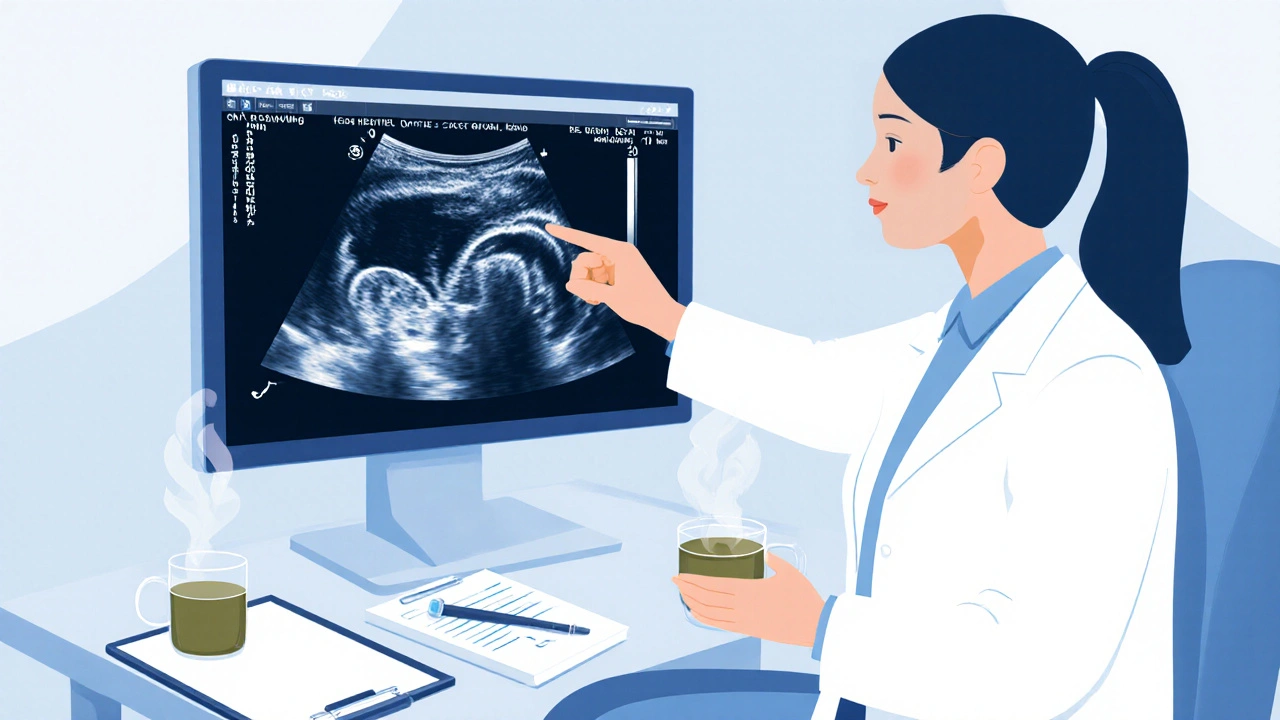Fertility Timeline Calculator
Post-Miscarriage Recovery Timeline
This tool helps you understand when it's generally safe to try for another pregnancy after a miscarriage. Based on medical recommendations, here's what to expect:
Recommended Timeline
Finding out you’ve had a miscarriage can feel like a punch to the gut. After the emotional shock, you’re left wondering: will my body still be able to get pregnant? The good news is that most people do conceive again, but the road back to pregnancy isn’t always a straight line. Below you’ll discover what actually happens to your body, when it’s safe to try again, and how to give yourself the best possible chance of a healthy pregnancy.
Key Takeaways
- Most miscarriages don’t cause long‑term damage to fertility after miscarriage; the uterus typically heals within a few weeks.
- Doctors usually advise waiting 1-3 months before trying again, but individual factors can shorten or lengthen that window.
- A simple blood panel and a brief ultrasound can reveal whether hormonal or structural issues need attention.
- Healthy lifestyle tweaks-balanced nutrition, moderate exercise, stress management-can boost odds of conception.
- Emotional healing is just as important as physical recovery; seeking support reduces anxiety that could affect ovulation.
What Happens to Your Body After a Miscarriage?
Miscarriage is the loss of a pregnancy before 20 weeks. It usually occurs because the embryo or fetus stops developing, which can be due to chromosomal issues, hormonal imbalances, or uterine abnormalities. When it happens, the body goes through a natural cleaning process: the lining of the uterus (the uterine lining) sheds, and hormone levels, especially progesterone and human chorionic gonadotropin (hCG), drop back to pre‑pregnancy levels.
Within a week or two, most women’s periods return, signalling that the uterus has healed. Rarely, scar tissue (called Asherman's syndrome) can form, especially after surgical dilation and curettage. That’s why a follow‑up ultrasound is recommended for anyone who had a surgical procedure.
When Is It Safe to Try Again?
There’s no one‑size‑fits‑all answer, but the medical community generally suggests a waiting period of 1-3 months. The idea is to let the uterine lining fully regenerate and give hormone levels a chance to rebalance. Here’s a quick timeline:
- Weeks 1-2: Bleeding stops, hormones dip, body resets.
- Weeks 3-4: First post‑miscarriage period arrives; you may notice normal menstrual symptoms.
- Months 1-2: If you feel physically and emotionally ready, you can start tracking ovulation.
- Month 3 onward: Many experts say this is an optimal window to try for a new pregnancy.
Women who have had multiple losses often wait longer, sometimes up to six months, to allow for additional testing and emotional processing.

Medical Checks Before You Try to Conceive
A short “pre‑conception” work‑up can catch hidden problems early. The most common tests include:
- Ultrasound - evaluates uterine shape, checks for polyps or fibroids, and confirms the lining is a healthy thickness (usually 8‑12mm).
- Blood hormone panel - measures progesterone, thyroid‑stimulating hormone (TSH), and prolactin to rule out endocrine issues.
- Genetic screening - if you’ve had two or more miscarriages, a karyotype or microarray can reveal chromosomal abnormalities that might repeat.
If any of these tests flag a concern, your doctor may recommend medication (e.g., progesterone supplements) or a minor procedure (like hysteroscopic polyp removal) before you start trying again.
Lifestyle Tweaks That Support Fertility
Even after a normal medical check‑up, everyday habits can swing your odds of conceiving. Here are the most impactful changes:
- Nutrition: Aim for a Mediterranean‑style diet rich in leafy greens, whole grains, nuts, and fatty fish. Folate (400-800µg daily) is crucial for early embryonic development.
- Weight: Being underweight (BMI<18) or overweight (BMI>30) can disrupt ovulation. A moderate weight loss or gain of 5-10% often restores regular cycles.
- Exercise: Light‑to‑moderate activity (30minutes most days) improves blood flow to the reproductive organs. Intense endurance training can suppress ovulation, so keep it balanced.
- Sleep & stress: Less than 7hours of sleep or chronic stress raises cortisol, which interferes with the hypothalamic‑pituitary‑ovarian axis. Mind‑body practices like yoga or guided meditation can lower cortisol by 20‑30%.
- Avoid toxins: Limit alcohol to ≤1drink per week, quit smoking, and reduce caffeine to ≤200mg daily.
Emotional Health: Healing the Mind as Well as the Body
Grief after a loss can linger, and anxiety about a new pregnancy may affect ovulation. Studies show that women who receive counseling or join support groups have a 15% higher chance of conceiving within six months compared to those who try to cope alone.
Consider these steps:
- Talk to a therapist who specializes in perinatal loss.
- Join an online or local miscarriage support group; hearing others’ stories normalizes your experience.
- Keep a journal to track feelings and any physical symptoms that might indicate when your body feels ready.
- Practice gentle self‑care-warm baths, light reading, or nature walks-to rebuild confidence.

Common Myths About Fertility After Miscarriage
There’s a lot of misinformation floating around. Here’s the quick reality check:
| Myth | Fact |
|---|---|
| “You’ll never get pregnant again.” | More than 80% of women conceive within a year after a single miscarriage. |
| “You must wait six months before trying.” | Medical guidelines suggest 1-3 months; waiting longer is only necessary for recurrent losses or specific health concerns. |
| “If the miscarriage was ‘late,’ your fertility is damaged.” | Gestational age doesn’t predict future fertility; most late losses still leave the reproductive system intact. |
Next Steps: Creating Your Personalized Plan
Putting all this together, here’s a simple checklist you can follow:
- Schedule a post‑miscarriage ultrasound and hormone panel (ideally within 4-6 weeks).
- Review the results with your OB‑GYN; discuss any need for treatment or further testing.
- Start tracking ovulation using basal‑body temperature or ovulation predictor kits once your next period arrives.
- Implement the lifestyle tweaks listed above-focus on diet, moderate exercise, and stress relief.
- Seek emotional support: therapist, support group, or trusted friend.
- When you feel ready (usually after 1-3 months), begin timed intercourse around the fertile window.
- Take a pregnancy test 14 days after intercourse. If negative, repeat the cycle; if positive, schedule prenatal care ASAP.
Remember, every couple’s timeline is unique. Keep communication open with your partner and your healthcare team, and give yourself permission to move at a pace that feels right for you.
Frequently Asked Questions
How long should I wait after a miscarriage before trying again?
Most doctors recommend 1-3 months, allowing the uterine lining to heal and hormone levels to normalize. If you had a surgical procedure, an ultrasound may be needed before you start trying.
Can a miscarriage cause permanent damage to my fertility?
In the vast majority of cases, no. The uterus and ovaries usually recover completely. Only rare complications like Asherman's syndrome or untreated infections could affect future conception.
Should I get genetic testing after a miscarriage?
If you’ve experienced two or more consecutive losses, a karyotype or chromosomal microarray can identify inherited anomalies that may repeat. Discuss testing options with your specialist.
Does stress really affect my chances of getting pregnant again?
Yes. Chronic stress raises cortisol, which can disrupt ovulation and luteal phase quality. Managing stress through meditation, counseling, or light exercise can improve fertility outcomes.
When should I see a doctor if I don’t get pregnant after trying?
If you’ve been trying for six months (or three months if you’re over 35) without a successful pregnancy, schedule a fertility evaluation. Early assessment can identify treatable issues sooner.

Maddie Wagner
October 9, 2025 AT 23:22We get it, the loss feels like a tidal wave crashing over everything you built.
When the tears subside, the body starts its silent repair, shedding the old lining and resetting hormones.
Science tells us that most uterine tissue regrows within weeks, and the ovaries stay ready to ovulate.
That’s why doctors often suggest a gentle waiting period of one to three months, just to give the body a chance to rest.
But rest isn’t only physical; emotional composting is just as vital for future conception.
Talk to a therapist, join a support circle, and let yourself feel every shade of grief without shame.
Track your cycle once your next period arrives – basal‑body temperature, ovulation kits, or simply noting cervical mucus can be your new compass.
Nutrition plays a starring role, too: leafy greens, whole grains, omega‑3s, and a daily folate boost lay the groundwork for a healthy embryo.
Moderate exercise, like brisk walks or yoga, fuels circulation without overtaxing the system.
Avoid the extremes of heavy drinking and smoking, as they can sabotage both hormone balance and egg quality.
If you had a surgical D&C, ask your doctor for a follow‑up ultrasound to rule out scar tissue, a rare but treatable issue.
Should any hormonal hiccups appear, a short course of progesterone can smooth the path forward.
Remember that each couple’s timeline is unique – there’s no race, only a rhythm that suits you both.
Open communication with your partner turns uncertainty into partnership and shared hope.
When you finally feel ready, trust that your body has done the hard work, and let optimism replace fear.
And above all, give yourself permission to move at the pace that feels true to your heart.
Kris cree9
October 12, 2025 AT 06:56Yo, if u think waiting longer than 6 months is some kinda moral test, u’re just trippin.
Paula Hines
October 14, 2025 AT 14:29It is a biological fact that the endometrium undergoes a cyclical regeneration process after any pregnancy loss the hormonal milieu readjusts and the hypothalamic‑pituitary‑ovarian axis resumes its oscillatory pattern the timing of which can be empirically observed through menstrual tracking the literature consistently indicates that a latency of one to three months permits optimal endometrial thickness the presence of a scar such as Asherman’s syndrome remains an outlier rather than a rule that surgical dilation and curettage occasionally introduces but is readily diagnosed by sonography the recommended preconception workup includes a transvaginal ultrasound a serum hormone panel and, when indicated, a karyotype analysis this trio of investigations can uncover structural anomalies hormonal insufficiencies or genetic etiologies that might otherwise recur the therapeutic armamentarium ranges from progesterone supplementation to minimally invasive hysteroscopic resection the overarching principle remains that patience coupled with targeted medical evaluation maximizes the probability of a subsequent successful gestation therefore adherence to a personalized timeline, informed by both clinical data and patient readiness, is indispensable
John Babko
October 16, 2025 AT 08:09Absolutely, the science is crystal clear, and we should trust it, because it’s backed by rigorous studies, not by anecdotal lore! The body’s natural healing mechanisms are universal, transcending any cultural myths, and they work the same for every individual! So don’t let anyone whisper doubt into your ear, especially those who peddle unverified “quick fixes”!
Dennis Owiti
October 18, 2025 AT 01:49I hear you, and it’s okay to feel angry-loss can stir up a storm of emotions, and you’re not alone in that.
Justin Durden
October 19, 2025 AT 11:09Take things one step at a time; a gentle walk, a balanced meal, and a quiet moment to breathe can slowly rebuild your confidence.
Sally Murray
October 20, 2025 AT 20:29From a clinical perspective, it is prudent to schedule a post‑miscarriage assessment within four to six weeks, encompassing ultrasonographic evaluation of endometrial thickness, serum quantification of progesterone, and, where indicated, thyroid function testing. Such a protocol facilitates early identification of pathological sequelae and informs the optimal timing for subsequent conception attempts.
Bridgett Hart
October 22, 2025 AT 00:16While your recommendation sounds thorough it ignores the psychological toll that many patients endure and assumes a one‑size‑fits‑all approach that is simply unrealistic
Sean Lee
October 23, 2025 AT 04:02Utilizing a systems‑biological framework, one can model the post‑miscarriage endocrine cascade as an intricate network of feedback loops, where perturbations in hCG and progesterone trajectories influence downstream angiogenic pathways, ultimately dictating endometrial receptivity thresholds.
Michael Christian
October 24, 2025 AT 05:02Sounds complicated, but in plain words it means giving your body a little time to reset before trying again can make a big difference.
Chelsea Hackbarth
October 25, 2025 AT 06:02Did you know that about 80% of people conceive within a year after a single miscarriage? 🤔📊 This statistic underscores how resilient reproductive health can be when proper care is taken! 🌼
Adam Shooter
October 26, 2025 AT 04:16One must caution against over‑reliance on aggregated percentages, for they obscure the nuanced etiological heterogeneity inherent in reproductive failure, thereby demanding a more granular, stratified analysis.
Anupama Pasricha
October 27, 2025 AT 02:29Remember, every healing journey is personal; honoring your own pace while gently integrating healthy habits can create a solid foundation for future pregnancies.
Bryce Charette
October 27, 2025 AT 21:56Just a quick tip: “its” should be “it’s” when you’re contracting “it is,” and “affect” is the verb you need rather than “effect.” Small edits, big clarity!
Christina Burkhardt
October 28, 2025 AT 17:22Thanks for sharing all this valuable info! 🙏 If anyone’s feeling uncertain, try a simple breathing exercise before bedtime – inhale for four counts, hold for seven, exhale for eight. It helps calm the nervous system and can improve hormonal balance. 🌿
liam martin
October 29, 2025 AT 10:02Ah, the age‑old quest for control over nature; we chase rituals like breathing patterns, yet the universe hums its own rhythm, indifferent to our dramatics.
Ria Ayu
October 30, 2025 AT 02:42True, but we can still find meaning in those little practices-they’re anchors that ground us while we navigate the unpredictable seas of fertility.